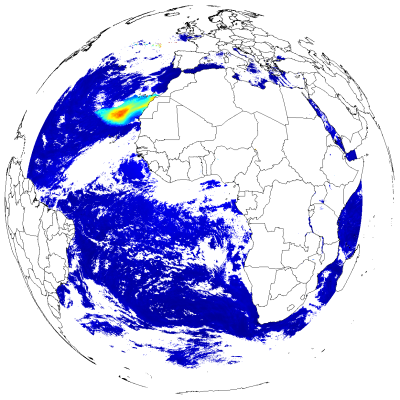What are the aerosols?
Tropospheric aerosols are
small solid particles that are in suspension in the
atmosphere. Their size is of the order of micrometer (i.e 0.0001 cm).
Why do we need to detect the presence of aerosols in the atomosphere?
The aerosols play an important role in the interaction of the radiation (
TIS,
TET and
TRS) with the atmosphere.
They also are important in the formation of
clouds and then they indirectly act on the greenhouse effect.
What kind of property do we retrieve from the satellite data?
We compute two
properties of the aerosols.
First, we retrieve the
optical depth. This is an optical quantity that says how opaque is an object: water cloud,
dust cloud, smoke plume or whatever.
We also compute the
direct radiative effect (or forcing) of the aerosols. This is the difference of
energy flux between what you would expect with a pure clear atmosphere (i.e. an atmosphere without dust, clouds) and what you actually measure (i.e.
TRS).

We then need in a first step to compute the
albedo of each pixel. As all these products are currently
only computed over
ocean and that we can consider the albedo of the ocean as constant in time. Nevertheless, we compute the albedo for each
year and not consider a fix a-priori value.
In a near futur (end of 2008), the optical depth will be retrieved over
non desertic land as well. Over the land the albedo follows a seasonal cycle, just think about snow or vegetation coverage. We
then will need to retrieve a seasonal albedo rather than a yearly value.
The next step will be to provide the same kind of products over desertic areas. That is why we are currently working on an
algorithm able to compute aerosol properties over desert thanks to the infrared chanel of
METEOSTAT imager.

|
|

|

|
|

)
|
Optical depth on the 12th February 2005.
A sand dust storm (non-blueish pixel) is blowing over Atlantic Ocean.
|
|
Direct radiative effect on the 12th February 2005.
Less energy is reflected in comparison with a pure clearsky.
|
Aerosol products
How to compute the albedo?
By definition the albedo is the ratio of the outgoinf flux over the incoming one. The outgoing is given by the GERB
measurement, we compute the incoming considering a fix value of the TSI (see TIS or STA for details and formula).
However, we want the value of the albedo for a
pure clearsky, i.e. a sky without clouds but also without dust (i.e. without
aerosol).
For a given pixel, we then compute the albedo for all the measurements without clouds. Thus we obtain a set of albedo values
corresponding to different situation of dust concentration. This dust concentration is roughly reflected in the
optical depth: higher the concentration, higher the optical depth.
Therefore to extract the albedo value corresponding to a pure clearsky (no clouds, no dust), we have to extrapolate
the albedo value to the zero optical depth value.







